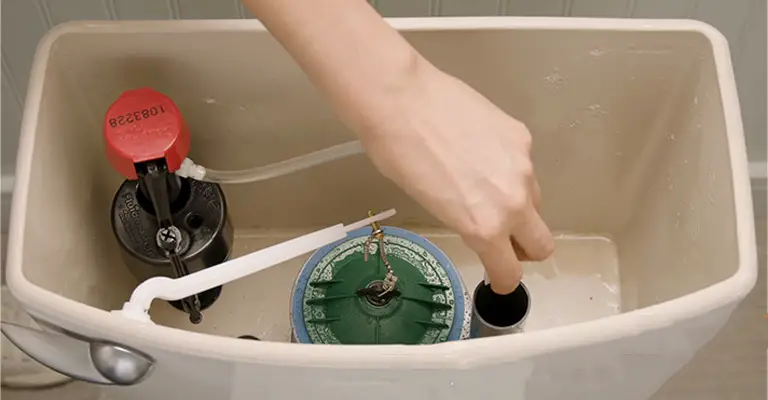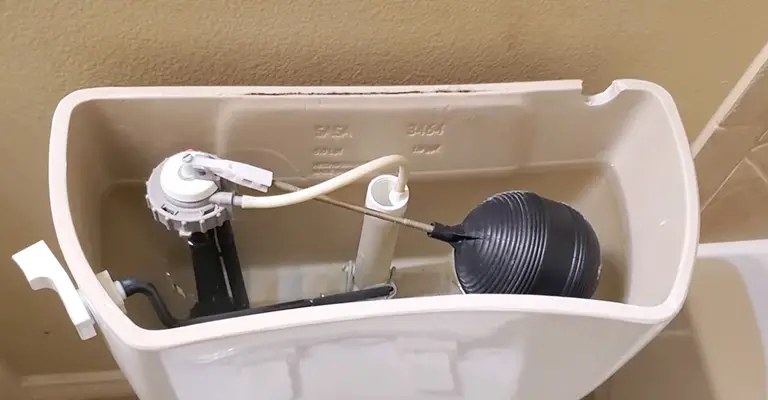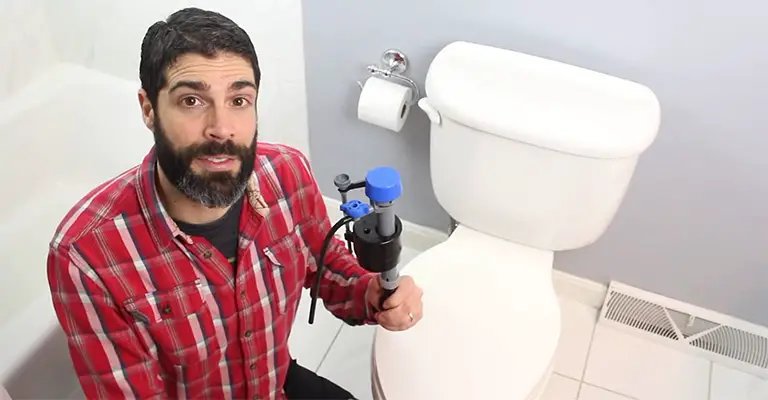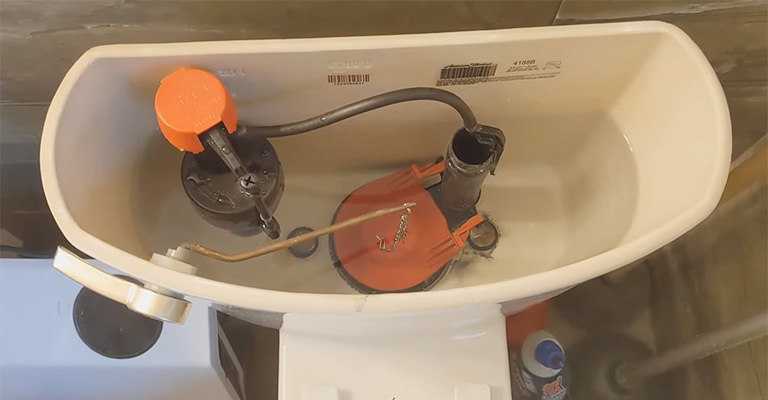Have you ever noticed your toilet suddenly filling up with water for a few seconds when no one’s using it? It’s a bit strange, isn’t it? But this issue isn’t just a minor annoyance.
It can lead to water wastage, higher bills, and even more significant plumbing problems. In this article, we’ll figure out why your toilet does this and find some easy ways to fix it. Let’s make sure your bathroom behaves itself!
There may be times when you hear your toilet refill spontaneously as if it had been flushed. Plumbers call phantom flush toilets that constantly flush but don’t switch off on their own or run intermittently.
This is caused by a slow leak from the tank to the bowl. The most likely cause of this problem is a bad flapper or flapper seat.
The solution is to drain and clean the tank and bowl, then check and replace the flapper if the flapper is worn or damaged.
Why Does My Toilet Keep Randomly Filling?
Flushing the toilet can cause various random plumbing problems, such as leaking or a change in the temperature of your shower.
The water in a flushing toilet typically ceases to run after a few seconds. Therefore, if you notice your toilet running continuously, this is a sign that there is a problem. The phenomenon is often referred to as phantom flushing.
A number of things happen when you flush the toilet at once. A lever raises the flap when you pull it.
There is a flap in front of the channel that takes water from the tank to the bowl. It opens to release all of the water into the bowl and into the drainage pipe, then closes once again to seal the tank.
Water returns to the tank after flushing the toilet by a float in the tank. When the tank has filled with enough water, and the float has risen into place, the toilet filling valve is closed.
Everything will be over in less than a minute if everything is set up correctly. Typically, a toilet idles for a few seconds before emptying without flushing due to a cracked flapper, the chain getting caught, the float needing to be lowered, or the refill tube needing to be shifted.
Problem: Refill Tube Could Require Repositioning

The refill tube can run continuously into the toilet bowl if it is too long or improperly positioned.
Refill valves create a suction effect, drawing water out of your fill valve and into your toilet. In this situation, the tube must be shortened or positioned just above the overflow opening.
Solution: Shorten the Refill Tube
Grasp the refill tube and take it out of the overflow. Cut it precisely at the height above the overflow opening by using cutting pliers. To keep it in the right place, clip it again to the side over the overflow tube.
Problem: Float May Need to be Lowered

There may be a problem with toilets overflowing or continuously running if the tank is filled with too much water. The overflow tube can fill up if the float is too high, and the water will pour into it.
In situations where the toilet keeps running intermittently due to an excess of water in the tank, the float should be lowered to keep the tank from filling up.
Problem: The chain Might Be Caught
Perhaps the chain has gotten caught if you have changed the flapper. A chain is attached to the lever you use to flush the toilet and lift the flap. Whenever the chain malfunctions, the water runs continuously.
An overly long chain, for instance, can get caught under the flapper and prevent it from sealing. An insufficient length won’t seal.
Solution: Lower the Float or Move the Chain
It may be necessary to lower the float if it is causing your toilet to run. Float arms are lowered by loosening or tightening their screws until the screw is tightened.
To avoid getting in the way and restricting flapper movement, simply trim the chain so that it isn’t too long or too short.
Problem: Toilet Flapper Could Be Cracked

There are several things that can cause your toilet to run off and on for a few seconds, one of which is a broken flapper.
When enough water has passed through, the flapper is supposed to drop down and seal the tank again, but a cracked or decaying flapper will allow water to keep flowing through.
When the flapper is raised, water is allowed to enter the bowl, allowing the water tank to remain sealed.
Solution: Replace the Flapper
You can remove the flapper if it appears damaged by turning off the water supply to the toilet and flushing it.
Using a sponge, clean up any leftover water, and then unhook the flapper and replace it with a new one. You may now turn on the water supply again and test it.
Whenever the toilet runs randomly, or the tank fills itself, it’s a sign that the flap is failing. The level has dropped because it does not cover the hole in the tank adequately, so water is escaping.
When the tank fills up beyond its capacity, pressure could cause even the newest flap to fail. However, replacement is necessary if the water level remains normal and the flap still isn’t sealing.
Tips on Solving Some Common Toilet Problems

Fixing common toilet issues is easy if you know how.
Water Trickling Into the Tank
The hissing sound you hear coming from your toilet could be caused by water running into the overflow tube. The diagram above shows how the water should rise in the tank to approximately an inch below the rim of the overflow tube.
Perhaps the float cup needs to be adjusted, or it may be stuck. Rotate the adjustment screw on the inlet valve assembly to adjust the float cup. The fill valve assembly may need to be replaced if no problems occur with the float cup.
The fill valve assembly might be clogged with dirt particles and debris from your home’s water line. This could cause your toilet to run constantly. As a way to remove debris, follow these steps:
- Go to the toilet and turn the water off.
- Lift the arm from the fill valve assembly to the float cup and rotate the top counterclockwise about 1/8 turn while pressing down. The cap should come off easily.
- Screw the top of the fill valve assembly back on over the top of a plastic cup you just removed. Slowly turn on the water supply to the toilet. Flowing water through the top of the fill valve assembly should clear out any debris there.
- Disconnect the toilet’s water supply and rinse the underside of the cap.
- Fit the cap back into the locked position by turning it clockwise. 1/8 turn, then turn on the water to your toilet.
Leaky Seals
It is typical for a toilet to have at least five seals that can leak. There is always a solution, and that is to identify the faulty seals and tighten or replace them. The one between the tank and bowl has the greatest diameter among the seals.
Whenever the tank is flushed, water will shoot out from beneath it when there is a break. As a result, the tank must be drained and removed in order to replace the seal. To gain better access, flip the tank upside down.
The old seal needs to be removed, and a new one should be put on. There is also the possibility that smaller seals at the mounting bolts and the base of the inlet valve assembly may fail, leading to more minor leaks. The same procedure applies here as well.
There are times when tightening the bolts or mounting nuts will stop a leak. Under the toilet base is the wax seal mounted on a plastic flange.
The “Johni Ring” seal prevents water leaks underneath the toilet base from rotting the floor. A caulk around the toilet’s base without repairing the leak will only trap water, worsening the situation.
You will need to remove the toilet and replace the wax seal if you have a leak around the base of the bathroom. Getting a professional plumber’s help is necessary if a broken flange causes the leak.
The Dreaded Clog
There are many common toilet problems, including clogs. It is possible to clear a clogged drain with several tools. If you want to clear minor clogs, a double-thrust force-cup plunger is more effective than the usual type.
Pump forcefully as you insert the bulb into the drain. Release the handle gradually, letting water flow into the drain to check if it’s clear. It is necessary to repeat if necessary.
Closet augers are effective for serious clogs. Twist the handle while pushing the rotor downward as you insert the end of the auger into the drain hole. It is important not to scratch the bowl while using it.
The Toilet Flushes Slowly
Clogged holes under the rim often cause a slow flush of the toilet. You can clear out debris by poking a curved piece of wire gently into each flush hole.
The coat hanger wire should work fine, and a small mirror will help you see under the rim. The wire can also be used to remove debris from the drain’s bottom that may be blocking the siphon jet. You should avoid scratching the bowl.
Final Words
There’s usually nothing complicated about solving a problem with a toilet that randomly runs for a few seconds. It can be challenging to compare bathroom plumbing to other kinds of plumbing.
You should always hire a licensed plumber to inspect any major plumbing issues you have. Maintaining and repairing the problem will be easier if this is done.
You can always trust that an expert plumber will be able to handle any plumbing issue you are unsure of how to handle, feel insecure handling, or simply do not want to deal with.








